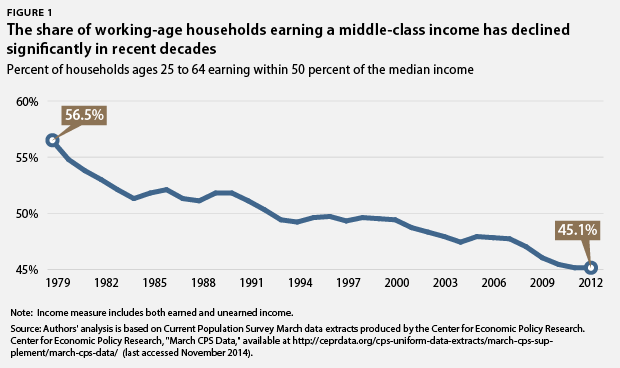America’s middle class is struggling. As recent economic data show, middle-class household incomes remain stagnant at a near-25-year low, and the share of the nation’s economic gains going to the middle class has fallen to near-record lows. Meanwhile, the costs of middle-class essentials—such as child care, higher education, health care, and housing—have rapidly increased. Beyond these well-documented facts, however, another long-term trend affecting the middle class has received somewhat less attention: As income inequality has steadily grown in the United States, the actual size of America’s middle class has shrunk.
A commonly used method to assess the strength of the middle class is to look at the nation’s overall income distribution and evaluate how a predetermined portion—for example, the middle 20 percent or middle 60 percent—is doing on a variety of indicators, such as what percentage of the country’s aggregate income it takes home or how its median wealth has changed over time. But an alternative method is to try to actually measure the share of Americans earning what can be considered a middle-level income. This is an income that falls within a set range of the national median—the income level that separates the top half of earners from the bottom half—which would identify a household as being middle class.
This analysis uses a range of 50 percent of the national median income—the same range used by Princeton economist Alan Krueger when conducting a similar analysis—and looks at all households between the ages of 25 and 64. This means all working-age households earning incomes between 0.5 and 1.5 times the national median will be considered part of the middle class. In 2012, this range spanned between roughly $30,000 and $90,000.
As shown in Figure 1, the share of working-age households falling into this middle-class range fell all the way from 56.5 percent in 1979 to only 45.1 percent in 2012. In other words, middle-class households were a clear majority in 1979, but today, they make up less than half of all households, and there is no indication that this trend will reverse in the near future. Over this time period, the United States has gradually transformed from a nation with many households clustered around the middle of the income distribution to an economy with larger and larger shares of the population concentrated at the top and bottom.

One of the key factors driving this relative shrinking of the middle class is increasing income inequality produced by uneven earnings growth. While the average incomes of the top 20 percent of earners grew by 42.6 percent in inflation-adjusted terms between 1979 and 2012, the average incomes of those in the middle 60 percent grew by only 9.5 percent, and the incomes of the bottom 20 percent actually fell by 2.7 percent. Essentially, those at the top rapidly pulled away from the middle, while the bottom simultaneously fell further behind it. The economic consequences of this dispersion of incomes and rising inequality may be substantial: A growing body of evidence suggests that income inequality negatively affects long-term economic growth.
America needs a vibrant and prosperous middle class to drive economic growth. Unfortunately, with the increasing economic inequality of the past several decades, the United States has become less of a middle-class nation, and those in the middle have found themselves increasingly financially squeezed and struggling to get by. It is time that policymakers take action to reverse these trends by working to boost middle-class incomes and to ensure that the essentials of a middle-class lifestyle remain affordable. Doing so will help rebuild the middle class so that all workers—not just those at the very top—can benefit from America’s future economic growth.
Keith Miller is a Research Associate with the Economic Policy team at the Center for American Progress. David Madland is the Managing Director of the Economic Policy team at the Center.